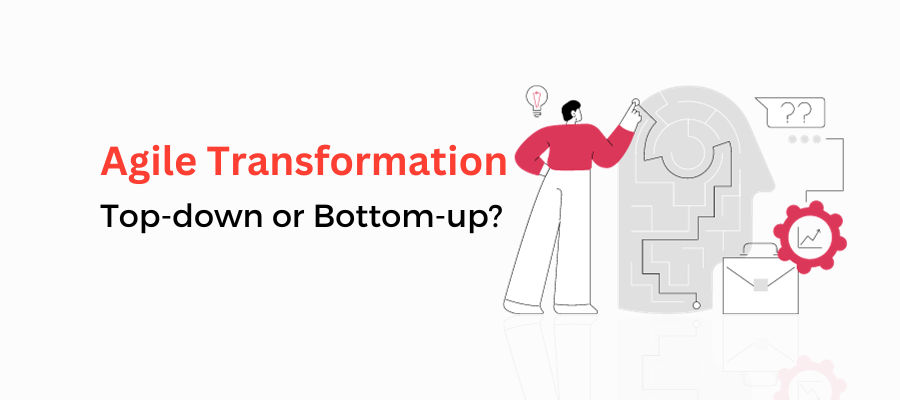Agile Transformation: Top-down or Bottom-up?

Most modern businesses are switching to Agile Transformation! With organizations striving to embrace Agile Methodologies, many need clarification about selecting the right approach or organizational transformations: Top-down or Bottom-up. Which is the right approach to initiate an Agile Transformation? Let’s discover more details about both approaches to reach a final decision!
What Does It Mean When We Say ‘Top-down’ Or ‘Bottom-up’?
Before we dissect the two approaches, let's clarify what 'top-down' and 'bottom-up' mean in Agile Transformation.
Top-Down Approach: This Transformation typically involves addressing the entire division or enterprise in one concerted effort. The organization’s senior management makes the decisions regarding Agile Implementation and Training strategies. This method requires thorough preparation over a more extended period. It enables the Agile Leader to communicate a clear vision and build an operating model to achieve the intended results!
Bottom-Up Approach: Conversely, the bottom-up approach empowers teams and individuals at the grassroots level to initiate Agile Practices. Teams gradually embrace Agile Principles, and the transformation permeates upwards through the organization. So organizations get enough time to fine-tune the operating model to their specific needs before scaling it up. However, a lack of understanding or resistance at any of those levels will impede the progress of the transformation.
Explaining Agile Transformation With The Top-Down Approach:
A strong leadership commitment characterizes the top-down Agile Transformation. Senior executives champion the shift toward Agility and often enlist the expertise of Agile Leaders such as Scrum Masters and Product Owners. As it follows a relatively short deployment model, the organization adopts Agility faster than the Bottom-up approach.
Key Benefits Of The Top-Down Approach:
The main reason why the top-down approach makes sense is because all employees follow their leaders! Listing here the other benefits of the top-down approach:
- Swift Decision-Making Clear Directions: A top-down approach ensures a clear vision and alignment with organizational objectives. With leadership backing, all decisions get executed quickly to complete the transformation process.
- Leading by Example: Leadership sets the tone by embracing Agile Principles. It develops a culture of accountability and showcases the commitment to change from the highest levels.
- Standardization of Opportunities: Organizations can standardize Agile opportunities through a top-down approach. This approach ensures consistent implementation across various teams and departments with a unified Agile vision.
- Adequate Funding: Senior management can allocate sufficient resources and funding to support Agile Training and Coaching across all teams. This financial backing is crucial for the success and sustainability of the Agile transformation journey.
Downsides Of The Top-Down Approach:
- Resistance from Teams: As mentioned earlier, teams might resist the changes, which can be a potential pushback and produce a slower adaptation rate.
- Lack of Real-World Understanding: Decision-makers may need a granular understanding of day-to-day challenges faced by teams.
Explaining Agile Transformation With The Bottom-Up Approach:
In the bottom-up approach, Agile Transformation begins at the grassroots level, with teams adopting Agile Practices organically. This method emphasizes empowerment and education at the team level, with teams self-organizing to implement Agile methodologies.
Once pilot teams adopt Agile Principles, the following teams adopt slightly improved Agile working methods. Likewise, the teams keep passing their findings and experiences to the following teams. This approach enhances the chances of completing the Agile Transformation successfully with improved performances.
Key Benefits Of The Bottom-Up Approach:
- Gradual Transformation for Risk Mitigation: Gradual transformation is best for the organization. This method allows for tracking the journey's increasing complexity and making immediate adjustments.
- Increased Team Engagement: Teams actively participating in the Agile journey are likelier to be engaged and motivated, fostering a positive transformation culture.
- Adaptation to Real-Time Challenges: Bottom-up transformations often yield solutions more attuned to teams' real-world challenges.
- Impressive Results Drive Organizational Interest: When initial teams showcase remarkable results with the bottom-up approach, their success catalyzes generating interest and buy-in throughout the organization.
Downsides Of The Bottom-Up Approach:
- Lack of Alignment: Without clear top-level direction, there is a risk of decentralized Agile implementations leading to misalignment with overall organizational goals.
- Slow Decision-Making: The bottom-up approach might be perceived as slow by organizations aiming for swift, comprehensive transformation.
Combining Both: Benefits of a Hybrid Model
The dichotomy between top-down and bottom-up approaches need not be absolute. Integrating elements of both strategies, a hybrid model can offer a balanced and effective Agile transformation. Here's why:
- Cultural Alignment: Top-down initiatives can ensure alignment with the organizational culture, while bottom-up approaches guarantee grassroots acceptance.
- Flexibility and Responsiveness: A hybrid model allows for swift decision-making from leadership and adapts to real-time challenges recognized by teams.
- Education and Learning: Integrating educational initiatives at all levels ensures a continuous learning culture, with workshops, coaching, and Agile training programs catering to a diverse audience—from Agile beginners to seasoned practitioners.
Summing Up:
So, which is the ideal Agile Transformation approach? Agile Transformation requires a tailored approach considering each organization's unique dynamics. A mix of top-down and bottom-up strategies can yield the most effective and sustainable results. The leadership should set the stage for Continuous Learning and motivate everyone to participate actively in the Agile Transformation process.
Reference:
https://www.linkedin.com/pulse/agile-transformation-approaches-top-down-bottom-up-360-salam-khan/



